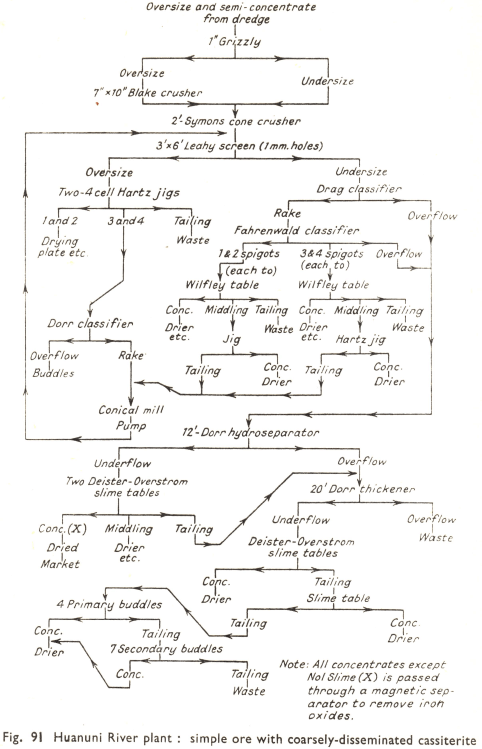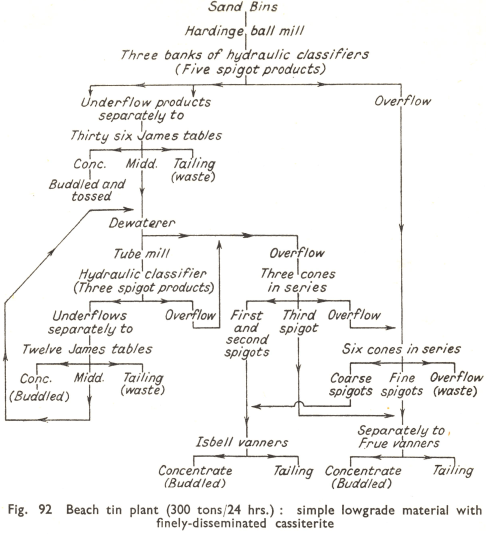The arsenic trioxide produced in roasting is collected in chambers, where it deposits on cooling, some 10,000 cu. ft. being allowed per ton of arsenious oxide per 24 hours. At South Crofty mine, Cornwall, these chambers are partitioned, so that the flue gases pass through some 400 ft., having a cross-section of 3 ft. by 6 ft. before going to wash towers and the atmosphere.
In tests carried out at East Pool mine, it was found that more than 90 per cent, of the arsenic was deposited in that portion of the flue with a temperature range of 297 to 340° F. The best temperature on the bed of the calciner was about 1, 100° F. and it rose to 1,340° F. above the bridge.
The crude oxide so produced usually carries a maximum of 94 per cent. As2O3, whilst the first and last condensate may contain no more than 50 per cent. As2O3. This product is next refined by revolatilisation in a reverberatory furnace, using anthracite or coke as fuel. The refined arsenious oxide (99.3 per cent.) is finally ground in millstones and packed in paper-lined casks.
The chief features in the treatment of simple ores are :
- the concentration of the Cassiterite as soon as it is freed, with the minimum of sliming,
- the production of a middling product for regrinding and subsequent treatment,
- close classification before concentration with thickening of all overflows before concentration,
- double treatment of the finest material and
- the re-concentration of all or part of the primary table concentrate.
Fig. 93 indicates the treatment given to accumulated sand tailing on a ” tin streaming ” plant in Cornwall. An interesting flowsheet given in Fig. 91 shows the method adopted for the re-treatment of jig products derived from the dredge operating in the Huanuni river bed by the Bolivian International Mining Company. The tin deposit contains very mixed material, ranging in size from minus 300-mesh up to boulders 2 ft. in dia. whilst pure Cassiterite is rare, practically all the tin occurring as rounded fragments of vein matter. These may assay anything from 1 to 30 per cent, tin and also contain some iron oxides. Preliminary concentration is effected on the dredge by jigging after sizing. From this plant, excess bedding, re-treated hutch products, and large fragments of veinstone removed by hand picking the oversize, pass to the re-treatment plant.
The feed to this plant usually assays from 4 to 20 per cent. Sn and receives a treatment such as might be adopted for a simple ore. Some 60 tons are handled per 24 hours and the final concentrates treated by magnetic separation in order to remove iron oxides.
A few years ago a 300-ton plant was erected at Gwithiam, Cornwall, for the recovery of tin from beach sand, but has now been abandoned. Here the Cassiterite is apparently derived from the accumulation of tailings deposited from older minging operations as well as the possible denudation of lode outcrops at sea. The flowsheet is given in Fig. 92 ; all table and vanner concentrates were buddled, tossed and sold as medium-grade concentrate. A rather astonishing feature was the presence of some arsenopyrite which occurred in chatty particles and was released by grinding. In recent tests it has been found that this material can be removed by flotation, along with metallic iron derived from the mills, and concentrated along with the Cassiterite, so that the final grade can be improved materially.


